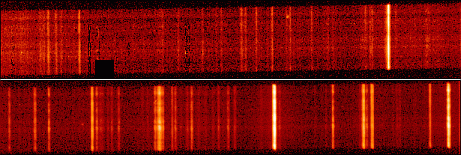10
Decorative Arts, Spectral
Posted by jns on 10 February 2009Still in operation, NASA’s SOHO (Solar and Heliophysical Observatory) spacecraft orbits the sun (not the Earth)
in step with the Earth, by slowly orbiting around the First Lagrangian Point (L1), where the combined gravity of the Earth and Sun keep SOHO in an orbit locked to the Earth-Sun line. The L1 point is approximately 1.5 million kilometers away from Earth (about four times the distance of the Moon), in the direction of the Sun. There, SOHO enjoys an uninterrupted view of our daylight star. (source)
One of the instruments on board is the Coronal Diagnostic Spectrometer (CDS), which was designed to study the atmosphere of the sun spectroscopically,* i.e., to look at characteristic wavelengths in the light put out by the corona, from which one can deduce quite a bit about the physical processes going on there.
On 26 March 2002 the CDS took a “quiet-sun” spectrum of the corona (meaning there were no particular disturbances, solar flares, or coronal discharges going on, just a normal, quiescent (such as it is) solar atmosphere. Below is the spectrum (shown one half above the other). The spectrum was taken in the extreme ultraviolet (EUV), so this red is dramatic false coloring. There are quite a few spectral lines visible, demonstrating the range and resolution of the CDS.

Evidently I am not the only one who thinks this spectrum is quite beautiful. It seems that the designers of this natatorium also thought so.

According to the SOHO page where I found this photograph, the mosaic is 20 meters long and constructed out of some 50,000 Italian glass tiles.
I want one.
———-
* Here is the official description of the CDS. It’s like scientific pornography for us experimentalists. Just let the words flow over you:
CDS consists of a Wolter II grazing incidence telescope which has a focus at a slit assembly which lies beyond a scan mirror. Light stops define two telescope apertures which feed, simultaneously into two spectrometers beyond the slit assembly. One portion of the beam hits a grating in grazing incidence and the spectrum is dispersed onto four 1-D detectors placed around the Rowland circle. This is the grazing incidence spectrometer or GIS. The other portion is fed through to a twin grating in normal incidence and the resulting spectrum is viewed by a 2-D detector system. This is the normal incidence spectrometer or NIS.
The GIS grating is spherical. The system is astigmatic, i.e. there is no spatial focus. Thus, one would use “pinhole” or square slits and build up images by rastering in two directions over the Sun’s surface. The rastering is performed by rotating the scan mirror (E-W rastering; i.e. by presenting different portions of the Sun to the slit) and by scanning the slit (N-S rastering). The four detectors sit at specified, fixed locations around the Rowland circle and thus detect the EUV spectrum in four fixed wavelength ranges.
The NIS gratings are toroidal, resulting in a stigmatic system. Thus, we may use long, thin slits and can image, spatially along the slits. Images of the slit are dispersed on the NIS detector producing an image, effectively, of wavelength against a spatial dimension. As a result, one can produce rastered images very quickly by rastering in only one dimension with the scan mirror. Since the NIS spectrum is dispersed by two gratings, slightly angled with respect to one another, two spectral ranges are viewed on the one 2-D detector.